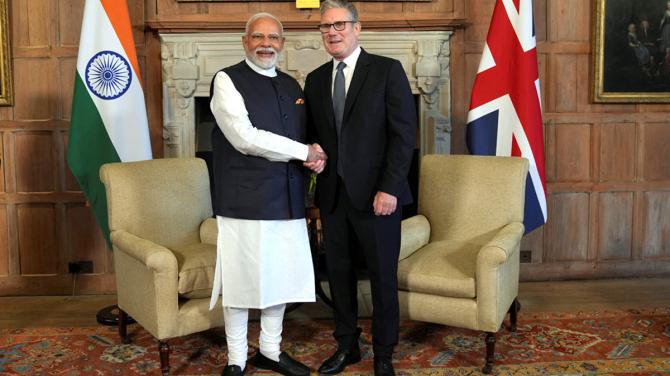Our Terms & Conditions | Our Privacy Policy
Auto: Will India-UK FTA Be Boon For British Cars?
For UK automakers, market access to India will be limited by quantity caps and phased tariff cuts, especially on petrol, diesel and electric vehicles.
IMAGE: Prime Minister Narendra Modi with British Prime Minister Keir Starmer at Chequers near Aylesbury, England, July 24, 2025. Photograph: Kin Cheung/Pool via Reuters
The India-UK free-trade agreement (FTA) eliminates duties on most Indian exports to the UK, though the auto sector has been liberalised through a cautious, quota-based tariff reduction scheme spread over two decades.
The agreement reduces or eliminates tariffs on 90-99 per cent of goods traded between the two countries.
For UK automakers, however, market access to India will be limited by quantity caps and phased tariff cuts, especially on petrol, diesel and electric vehicles. The deal is not yet in force and awaits ratification by the British parliament.
Why automobiles is most sensitive sector
Automobiles have been among the toughest issues to resolve in the India-UK FTA negotiations. At present, India imposes import tariffs above 100 per cent of fully built foreign cars.
These tariffs provide high barriers to entry, protecting domestic manufacturers such as Maruti Suzuki, Mahindra, and Tata Motors from competing to secure sale market share in India since the Indian market is price-sensitive.
UK officials and auto manufactures had pushed for drastic tariff reductions to boost exports of UK manufactured vehicles, but Indian negotiators sought long phase-in periods and limits on imported vehicles, arguing that if there was a sudden influx of foreign vehicles, the Indian auto industry would be hurt and India would not achieve its domestic and EV manufacturing goals.
How will UK petrol, diesel, and electric cars enter India?
Under the FTA, tariffs on UK petrol and diesel vehicles will only be reduced to 10 per cent by 2031, and even then, only for vehicles imported under a quota system.
For the highest-capacity engine cars, the first-year in-quota duty drops to 30 per cent, falling to 10 per cent by year five.
Out-of-quota tariffs reduce more gradually, reaching 50 per cent by year ten.
High-end carmakers like Bentley and Jaguar Land Rover (owned by Tata Motors) will face tariffs as high as 30 per cent in the early years, and lower-end cars will be subject to an even steeper 50 per cent duty before that rate drops to 10 per cent in year five of implementation.
The number of vehicles that qualify for these reduced tariffs is capped. The initial quota of around 20,000 vehicles per year will rise to 37,000 by 2031, but then decline to 15,000 units by 2046.
Electric and hybrid vehicles have separate conditions. Only those priced above Pound 40,000 qualify for tariff relief, with import caps starting at 4,400 units in 2031 and rising to 22,000 by 2040.
Lower-priced EVs, where Indian companies are investing heavily, are excluded from the benefits.
The full tariff reduction plan is structured over a 10-15 year period, and tariff savings from auto imports are estimated at Pound 1.7 billion by 2041, according to projections cited by the Financial Times.
How are UK automakers responding to the deal?
Despite achieving a pathway to the Indian market, UK carmakers have reacted with caution.
Industry executives welcomed the eventual tariff reduction but criticised the complexity and duration of the implementation plan, the Financial Times reported.
Under the deal, automakers must wait until 2031 for the lowest tariff rate to take effect, and even then face quotas that decline over time.
Industry insiders described the agreement as “watered down”, and pointed out that high tariffs in the early stages, 30 to 50 per cent, will limit price competitiveness and consumer uptake in India.
Firms such as Jaguar Land Rover may benefit in the long run, but short-term gains appear minimal.
The British automotive industry had lobbied for a more immediate reduction in tariffs and broader access, especially for EVs and mid-range vehicles.
Why India still holds the keys in the UK car import deal
India has retained strong protective safeguards in the auto sector, arguably the FTA’s most guarded chapter.
While the UK gains long-term access, India continues to shield its mass-market segment from foreign competition.
Tariff cuts are tied to vehicle prices and volumes, and no significant liberalisation has been granted for lower-cost EVs or small cars, where Indian firms are building global competitiveness.
These exclusions are deliberate, aimed at preserving domestic industry during a critical growth phase.
At the same time, Indian firms are expected to benefit from zero-duty access for auto parts exports to the UK.
This could support companies such as Bharat Forge, Motherson Sumi, and Sundaram Clayton, whose components are already part of UK supply chains.
When and how will the India-UK trade pact be implemented?
The FTA will come into effect once ratified by both parliaments, which is expected some time in 2026.
From there, a detailed implementation timeline will govern the staggered roll-out of tariff reductions.
The auto tariff structure, including quotas, timelines, and rates, will be reviewed periodically.
A bilateral safeguard mechanism is included in the agreement to address any future trade disruptions or domestic market concerns.
Feature Presentation: Aslam Hunani/Rediff
Images are for reference only.Images and contents gathered automatic from google or 3rd party sources.All rights on the images and contents are with their legal original owners.



Comments are closed.